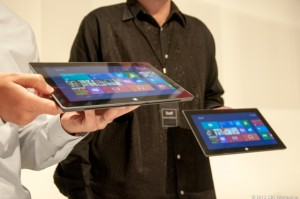The worldwide tablet market is exploding with demand as people jettison laptops for smaller, touch-based devices. But even as tablets become must-have personal computing devices, Windows, and particularly Windows 8 tablets, won’t be a major factor until at least 2016, according to an online report.
Slates running Microsoft’s operating system are expected to account for just 2.9 percent of the worldwide tablet market by the end of 2012, rising to 10.3 percent in 2016, according to market research firm IDC.
IDC recently increased its overall tablet market forecast, predicting worldwide shipments to hit 122.3 million units, up from the previous forecast of 117.1 million devices shipped. By 2016, the research firm expects tablet shipments to reach 282.7 million units, up from the previous forecast of 261.4 million.
Most of the tablet activity over the next three years will involve the ongoing struggle between Apple and manufacturers of Android devices. In the latest salvo of the Apple-Google death match, Apple in October released the iPad mini to compete with smaller, popular tablets such as Google’s Nexus 7 and Amazon’s Android-based Kindle Fire line up. There are also rumours that Google is prepping an Asus-built $99 Android Nexus tablet.
By the end of 2012, IDC expects Apple’s iPad line to account for 53.8 percent of worldwide tablets shipped, followed by Android tablets at 42.7 percent. By 2016, IDC believes Apple will still be on top with about 49.7 of tablets shipped, and Android will follow with 39.7 percent. Both tablet platforms are expected to grow on average by about 21 percent per year, according to IDC, which, along with PCWorld, is owned by International Data Group.
Windows tablets, meanwhile, will explode in popularity, relatively speaking, growing by an average of more than 69 percent per year between now and 2016. That fast growth will allow Windows to climb from 2.9 percent in 2012 (including Windows RT, Windows 8, and Windows 7 tablets) to the lofty heights of 10.3 percent by 2016. By that time most Windows tablets should be running Windows 8 or its ARM-based variant, Windows RT. Windows 7 tablets, meanwhile, which account for a slim niche among enterprises, should be rendered more irrelevant than they already are.
But what will happen to Windows tablets beyond its predicted gains up until 2016? Will Windows 8 and succeeding Microsoft OS tablets continue to grow at a relatively fast rate? Or will the pace slacken, rendering Windows a distant third in the tablet race behind iOS and Android? The prospect of being an also-ran in the battle for the next generation of personal computing devices has to be keeping Microsoft executives up at night.
It’s too early to say that Windows won’t be a dominant software platform for the next generation of computer users who are expected to grow up using tablets. But with Android and iOS having a head start on their software platforms and the chance to build up some impressive app catalogues, it’s tough to see how Microsoft will ever become a significant force in the tablet market, at least in the near future.






